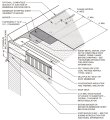
This gravel stop detail is courtesy of the NRCA. The NRCA suggests avoiding (where possible) flashing details that require rigid metal flanges to be embedded or sandwiched into the roof membrane.
Perimeter Gravel Stops
Perimeter gravel stops serve four primary functions on a roof system.• They act as a barrier to hold aggregate in place.
• They serve as an edge termination for the membrane.
• They act as a rain shield.
• They serve as top surface for securement of the fascia metal.
Materials
The materials used for gravel stops must be metal or pre-molded plastic. The material must be watertight and flexible enough to accommodate thermal and differential movement. The flange width should be a minimum of 4 inches and not greater than the width of the nailer. Metal thickness should be in compliance with Factory Mutual Loss Prevention Data Sheet 1-49.
The gravel stop should be raised above the roof elevation with a sloped cant strip or wood nailer.
Execution
To set up a perimeter gravel stop:
1. Install flashing materials similar to the dimensions necessary to accommodate the flashing ply configurations shown on the related drawings.
2. Install one two-by-four wood nailer at perimeter edge to receive flashing and new metal.
3. Install one ply of flashing strip-in over the top of the nailers and down and out onto the roof approximately 6 inches beyond the base of the wall in an even application of the approved adhesive.
4. Following the same procedure, install a second ply of flashing membrane. This ply shall extend from the maximum flashing height down and onto the roof, approximately 2 inches beyond the previously installed ply.
5. Install a new perimeter edge fascia/gravel stop fabricated from similar metal material and color to match existing perimeter metal in width and fascia height. The gravel stop shall be secured with the appropriate fasteners every 8 inches on center.
6. Apply the approved butyl rubber sealant caulking at all metal coping joints. Caulking shall be completed in accordance with the manufacturer’s latest printed specifications.
7. Seal all flashing seams with an application of roof adhesive, membrane and aluminum coating.